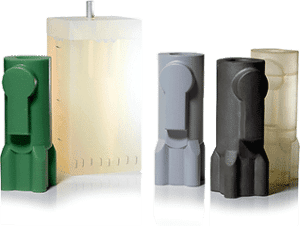Overview
Room Temperature Vulanization (RTV) molding is another type of silicone molding where finished products are used for prototyping, functional testing, and short-run production. Utilizing both Polyjet and FDM materials technology, reduce time, labour, and cost of silicone molding as 3D printing makes it possible to produce a prototype pattern in less than 24 hours. Without the traditional constraints of machining, your design can be more complex without increasing cost.

Polyjet
With its inkjet-like process, Polyjet delivers extremely detailed parts with high resolution and smooth surfaces. Patterns printed with this technology are typically mold-ready and have subtle details that can be transferred to the urethane castings. Additionally, complex and intricate patterns can be printed without adding time, cost, or risk to the design process and are ready in as little as 24 hours. As long as you don’t exceed the capacity of the 3D printer, many Polyjet patterns can be produced in a single build and at a fraction of the time required to make them separately.
FDM
Silicone molding with FDM patterns is a 3-step process:
- Design FDM pattern
- Make the mold by covering pattern with silicone and allow it to cure
- Cast the urethane in the mold
Printing mold patterns with FDM is an alternative method that is quick and cost-effective. The production-grade thermoplastics used carry excellent durability, strength, and resistance properties that allow silicone molded products to be created faster and cheaper than ever before. Design complex patterns with hollow canals and thin walls. Even through multiple design revisions, a new pattern can be ready for use in hours.